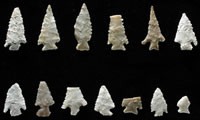Bow and Arrow
The bow and arrow replaced the atlatl and dart as the principal weapon system for hunting large game and for warfare in the region beginning around 1300 years ago (A.D. 700). The new technology spread across much of North America around this time, although its precise origin is unknown. In the Plateaus and Canyonlands, the technological shift was complete within a few centuries at most.
Compared to its predecessor, the bow and arrow was more compact, lighter, faster to reload, more stealthy, and allowed hunters and warriors to carry many more rounds (arrows) with them. Arrows were tipped with lightweight arrow points—true arrowheads—which could be made from smaller pieces of raw material and with less effort than dart points. With a powerful bow, a skilled hunter could bring down a deer, a man, or even a bison with one well-placed shot. To learn more about the earliest culture to adopt the bow and arrow in the region, see the 11-section exhibit on the Graham-Applegate site.
